Word of Mouth - Questions and Answers

Galway Bay FM – Dr Paul Moore DBS “Word of Mouth”
In this blog we will try and answer some of the questions that you, the listeners send in in more depth with some images and links to further reading:
------------------------------------------------------------------------------------------------------------------------------------
March 22nd 2021
Question: There are times that my inner cheek enlarges and I seem to bite it with my back teeth. Why does this happen? As I said it doesn't happen all the time but it feels like the inner cheek puffs up and then it's gone a few days layer.
Answer: Cheek biting may be caused by accident or trauma and can be also from a habit. It is also known as morsicatio buccarum
Ok, this might sound like a little thing, but I know it can be quite distressing.
The skin inside your mouth is called the MUCOSA. It is very clever stuff with minor salivary gland everywhere to make it wet and slippery and high in your cheek you also have some of your bigger salivary glands called the Parotid gland.
Cheek chewers may perceive a small lump, lesion, or blemish which they feel compelled to remove from the skin inside their mouth. They may experience an overwhelming urge to remove the blemish by chewing it away, at which point they get stuck in a sort of emotional and behavioural loop, repeating the action in a way that feels out of their control.
The position of the teeth relative to each other can also have a big influence. Commonly the top teeth sit outside the bottom teeth, and the cheek will lie against these top teeth like a “curtain on a shelve,” keeping the soft tissue of the cheek away from the biting bit.
If you catch the cheek between the top and bottom either because there is a tooth out of line, there might be a gap between your teeth or crowns, you might be missing one or more teeth that spoils the “shelve”-like effect. The muscles of the cheek will tighten in and cheek biting can happen with in your sleep, while eating or as a sub-conscious habit, like biting your nails.
We will see this also when a patient has wisdom teeth that are poorly aligned.
If you have broken the skin, you may can an ulcer from the trauma, if you have bruised the cheek the swelling will often take 7 10 days to settle.
What can you do about it.?
Action: Do see your dentist? There are many other factors that they may have to consider. You may have a variety of other factors and you should seek advice to find the correct diagnosis and the correct treatment.
Question: I've noticed small white blotches on my son's teeth like bleach stains. He doesn't use teeth whitening so what could it be?
Answer:
There are a number of causes of white spots on teeth including…
• White spots left on teeth after orthodontic treatment.– Patients who consume large amounts of acidic or sugary foods/beverages whilst fitted with non-removable braces (e.g. traditional metallic braces) may notice white spots on the teeth when the dental cement used to hold the braces in place is removed. This is because acidic or sugary food/beverages can cause demineralisation of the enamel layer (early decay). This process causes the tooth surface to become discoloured and opaque.
• Fluorosis – uneven development of the enamel – Fluorosis is linked to an increased intake of fluoride – this can be from natural sources or ingestion. The increased intake of fluoride during the tooth’s developmental stage can lead to an amount of fluoride being deposited in the tooth, causing white spots on teeth that are yet to erupt through the gum. This can be related to some geographical ares of the world more than others
• Enamel hypoplasia – Enamel hypoplasia can affect both primary teeth (baby teeth) and secondary teeth (adult teeth). The term covers any abnormality in the normal development of the tooth – where pits or grooves form naturally, or where part of the crown does not develop fully, the tooth may appear naturally mottled/spotted with a higher susceptibility to staining. This hypoplasia can be as a result of early illness, physical trauma, reaction to certain medicines or local factors such as an infection of the baby tooth disrupting the growth of the adult enamel.
• Demineralisation – Demineralisation is the technical term for any loss of tooth enamel due to tooth decay. The wearing down of the surface of the tooth exposes different layers of the tooth, which may create a frosted or white spotted effect. With continued loss of the enamel structure, the tooth will succumb to cavitation, further decay, and eventual tooth loss.
Question: My daughter is 6 and her two front teeth (second teeth) are growing down well but they are slightly overlapped. She still has her baby teeth either side of these.
Will they even out when the others are gone??
Answer : 6 is a great age. Teeth-wise all sorts is happening. The baby front baby teeth have done their job and they start falling out at the front as the grown up teeth push through and dissolve the roots of their predecessors.
The grown-up back teeth grow through behind the bay teeth, usually at the same time. Certainly it is not uncommon for the new adult teeth to be a little "squashed" into the space of the child's jaw. Over the next years the dimensions of the child's face and upper and lower jaws will growth and expand to let the developing teeth slide into place.
So celebrate the new teeth and do not worry.
March 8th 2021
Question: Are you allowed free dentures on the medical card? from Tina
Answer :On the HSE.ie website https://www.hse.ie/eng/services/list/2/dental/ the guidelines state:
Dental Services in Ireland are provided by two main types of service:
Private Dentists, who see their own patients and also many of whom provide services for people with medical cards.
HSE Dental Clinics, who provide services for children from birth to 15 years. This service is accessed through screening appointments in your child's primary school.
Use our Service Finder Map to find Dentists near you now.
What Dental Services are provided to people with Medical Cards?
Adults (over 16 years of age) who have a valid medical card can access a range of dental services and treatments under the Dental Treatment Service Scheme.
All medical card holders are entitled to specific dental treatments e.g., a dental examination, two fillings in each calendar year, extractions as necessary.
Some treatments such as the provision of dentures require the approval of the HSE before the dentist can proceed and in this case, the dentist applies directly to the HSE.
Additional treatments for example, teeth cleaning are available to those persons with specific medical conditions and again, your dentist will be able to advise you of your entitlement if this is the case. The HSE dental section may require written documentation outlining your medical condition and/or medications from your G.P. or other relevant medical person.
Question: Can u ask the dentist, I had braces and I want to get new night retainers, but don’t want to spend a lot of money on them. I’ve been quoted €320. It’s too expensive.
Do you know where I could go to get them cheaper. Tks
Answer. This is a good question, but not a simple answer.
There are many types of retainer that a dentist can recommend to suit the needs of a patient. Simply comparing costs without comparing needs will not always give you the answer you are looking for our orthodontist may have offered you one sort of retainer for a specific reason.
There are two basic types of retainers: removable and permanent. Your orthodontist helps you choose the best type for you based on what you needed braces for and any conditions you might have. You may be given only one type, or you may receive a removable retainer for your top teeth and a permanent one for your bottom teeth.
A retainer keeps your teeth from moving after they’ve been straightened with braces. It can take at least 6 months for the new position of your teeth to become permanent. During that time, your teeth will try to shift back to their original position, which is called relapse. When used as instructed, a retainer prevents this from happening.
The advantages of removable retainers are:
They’re easily removed when you want to eat and to brush or floss your teeth.
They’re relatively easy and convenient to get.
The disadvantages are:
They can be misplaced or lost when not in your mouth, especially if they’re not kept in a case.
They can be easily damaged if left lying around.
They can cause excess saliva production.
Bacteria can grow and live on them.
The biggest problem with removable retainers is that relapse is common. This is because people may lose the retainer and not replace it or don’t wear their retainer as often as instructed. When you don’t wear it, it can’t work like it’s supposed to, and your teeth will try to shift back to their original position.
Both types of removable retainers should be removed and cleaned with gentle brushing daily .
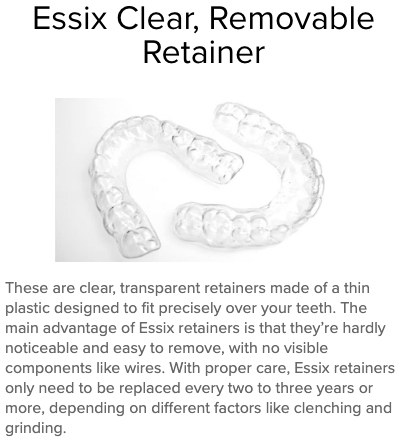
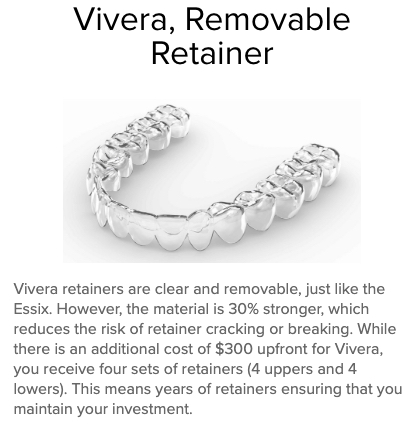
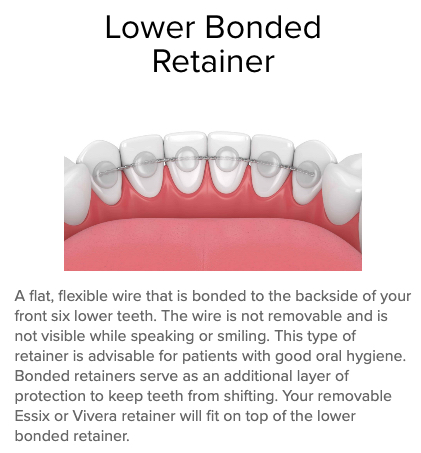
There are two kinds of removable retainers: Hawley and clear plastic retainers.
Hawley retainers
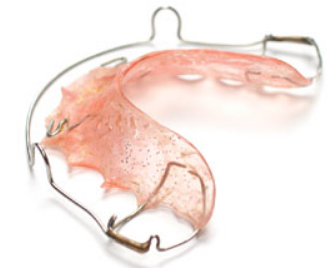
Also called wire retainers, these are removable retainers made of thin metal wire and plastic or acrylic shaped to fit the roof of your mouth or along the inside of your lower teeth. The attached metal wire runs across the outside of your teeth to maintain alignment.
The Hawley retainer has these advantages:
The retainer can be adjusted if you need a better fit when you first get it or if your teeth need slight realignment later.
It’s slightly more durable than a clear plastic retainer.
It may be repairable if broken.
It can last for years if used and cared for properly.
The upper and lower teeth touch naturally with this type of retainer. Its disadvantages:
It affects your speech more than other retainers. It’s more noticeable than the other types of retainers. The wire may irritate your lip or cheeks initially. Average cost varies from about €150 to €340.
Clear plastic retainers
These are removable retainers that are molded to perfectly fit the new position of your teeth. They’re also called molded retainers. (The technical name for them is thermoplastic or vacuum-formed retainers.)
To make this type of retainer, a mold of the teeth is created. A very thin plastic or polyurethane is then heated and sucked down around the mold.
A clear plastic retainer has the following advantages: It’s virtually invisible, so you’re more likely to wear it. That means relapse is less likely. It’s less bulky and may be more comfortable than a Hawley retainer. It’s less likely to affect your speech than a Hawley retainer.
Disadvantages of a clear retainer: It can’t be adjusted if you need realignment. It would need to be replaced. If it cracks or breaks, it can’t be repaired.It may affect your speech more than permanent retainers. It can warp if exposed to heat. It tends to become discoloured (and more visible) over time. Top and bottom teeth don’t touch naturally with this type of retainer. It can trap liquids against your teeth, which can cause cavities.
The main difference in the three common brands of clear retainers is the type of plastic material they are made of.
Clear plastic retainers have become more and more popular and are used more often than Hawley retainers.
Why a retainer?
Even after your teeth are permanently in their new position, the effects of chewing, growth, and everyday wear can lead to relapse. So your orthodontist may recommend that you use a retainer for the rest of your life.
If your retainer is removable, it’s very important to wear it exactly as your orthodontist says, or you might lose some or all the benefits of your braces. The most common instructions are to use a retainer all day, seven days a week for one year after braces are removed. Then it’s usually recommended the retainer be worn at night indefinitely.
Instructions vary, so it’s important to talk to your orthodontist about this.
Once you start using your retainer, your orthodontist will want to check your teeth to be sure your retainer is keeping them from moving. They may adjust or fix the retainer or make a new one if needed. You may be recommended to have checkups 1, 3, 6, 11, and 24 months after your braces are removed.
You should see your orthodontist as soon as possible if you lose your retainer or it cracks or breaks. That way it can be replaced before your teeth relapse.
Bottom line: There are pros and cons to each retainer type. Your orthodontist will recommend the best type for you based on your teeth and why you needed braces. But don’t forget to consider your preferences on the look and amount of time and effort you are willing to spend on it. You will most likely be using and maintaining your retainer for many months or years, so it’s important that you have the type of retainer that works best for you and that you’ll use as instructed.
Question: What age do you start brushing baby’s teeth once they start to show? A mammy.
Answer: I can answer this as a dad of 9 children and a dentist.
My suggestion is to start brushing your babies gums at bedtime, as soon as you can. Way before the new teeth come through. If you haven’t started its never to late. This is a great habit to get into and can become just one of the normal rituals that you do with your baby every day at bedtime.
Get a small soft brush and rub the upper and lower gums gently for the length of time it takes to sing a nursery rhyme. I would lie my children on the floor and either sit down next to them or even lie them down with a towel wrapped around the to start with if they a too wriggly. Take a good minute the gently make this a bit of fun.
When the teeth come through its no different and easily accepted.
Best thing is, no one else has to hear me sing and baby doesn’t criticise my singing…
So what’s your favourite nursery rhyme?
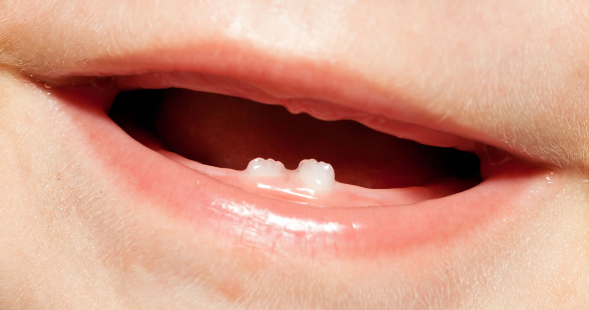
Question: I have a sensitive sore boil on the roof of my mouth, it seems to have travelled to a nearby tooth. Is it related, and is it dangerous? Thanks, Evan.
Answer: The correct answer here is always going to be “Go and ask your Dentist”
A bump or ulcer can be a range of many things from simple and transitory to complex and urgent including:
An “apthous”ulcer. - remarkable common and will probably last 7 - 10 days.
The soft tissue reaction to a scratch, cut, bruise or burn.
A cold sore. Not the most common place for a cold sore, but does happen
A mucous cyst. - this is a little damaged mucuos / saliva gland.
A “Dental Abscess” of the root of a tooth or the gum.
More seriously a bumps or ulcer that persists could be a soft tissue cancer that if easily identified and acted on early can be treated so much more easily and successfully.
Question: How long should you use a tooth brush for. If it’s good quality and the bristles stay strong, can you continue to use it?
Answer: Certainly the better the quality to longer the toothbrush will last. In a nutshell you should change the toothbrush once the bristles start to bend.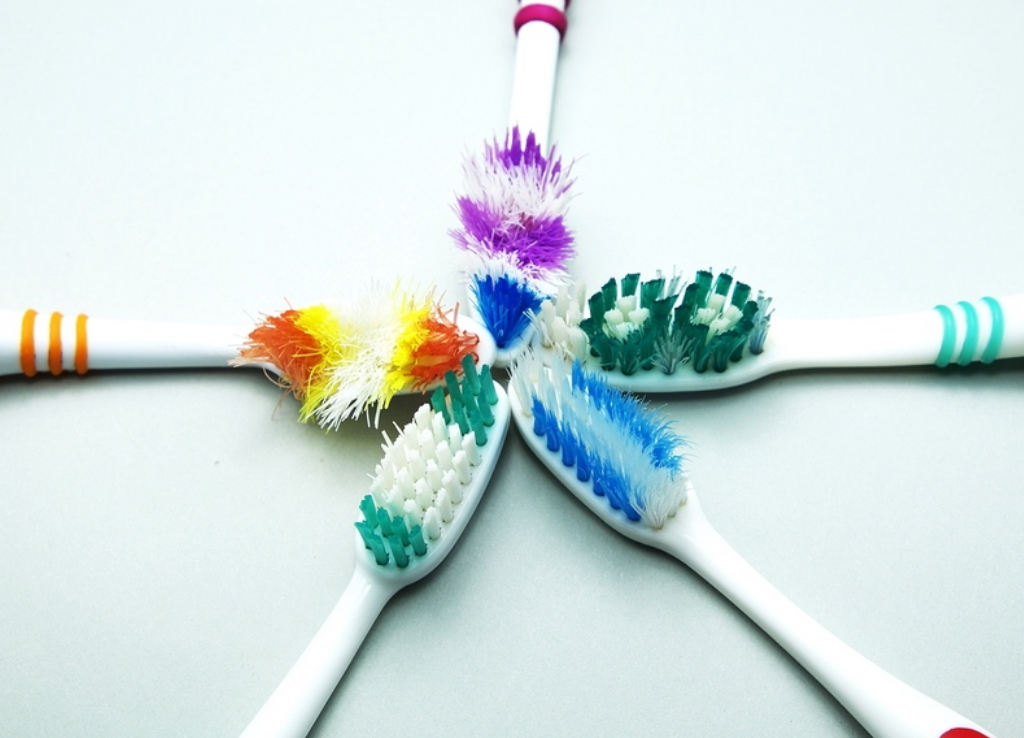
Question: Will you please tell my son to clean the sink after he spits out the toothpaste. Could you also tell him the tap is there, not for decoration but to wash away excess
paste!!! Angry Mother!
Answer. Ah the joys of parenthood.
My message to your son. “ I know who you are. I know where you live. Clean your teeth and clean the sink or I will tell the tooth Fairy!”
------------------------------------------------------
Feb 22nd
Question: Ask the dentist hi what Is the best way to remove very stubborn stains from bottom of my teeth near gums .Stains from smoking and coffee have tried all expensive tooth whitening treatments and toothpaste thanks.
Question: How can you successfully remove tartar or plaque without spending a fortune.
Answer: These are both great questions and we get asked these frequently.
First let’s consider what is the cause of the problem.
Every day plaque ( bacteria ) will multiply on your teeth and gums. This is basically a “colony” of bacteria that love the warm and wet environment of your mouth which is warm and moist.
When you eat, it adds fuel to the growth rate. It’s a perfect environment for growth of bacteria – a bit like a petri dish - and the bacteria will grow in all the nooks and crannies ( my brother calls these “crooks and nannies” ) and the colony of bacteria becomes more structured and developed.
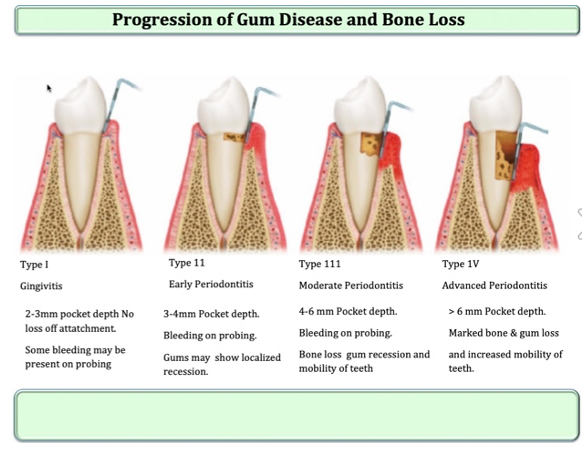
As it does so the calcium from your saliva is absorbed by the bacteria and it calcifies – similar to the process that creates coral reefs in the ocean. This calcified bacteria sticks like hell to the tooth structure of the root and creates a rough surface for more bacteria to grow.
This “porous” structure we call “calculus” and it will absorb stains and colours as well as more bacteria.
The BEST way to control this is to prevent the daily accumulation of the bacteria by mechanically removing the colony of bacteria by
Daily at home:
1. Brushing all the nooks and crannies and focus on where the tooth joins the gum. There is a sleeve or “pocket” of gum around the neck of the tooth where the bugs can hide. Focus on this. Manual toothbrushes are fine and can do the job perfectly . Electric toothbrushes ARE good and can make the job easier for some people.
2. Flossing – this reaches into the sleeve and between the teeth where the brush cannot reach.
3. Mouthwashes can help. Ask your dentist which is the best mouthwash for you, but use the mouthwash AFTER you have brushed and preferrable flossed. Use the mouthwash for at least one minute to give it time to work.
Professionally at the dentist:
1. Your dentist and/or hygienist can remove the calculus you cannot. This stuff is tough and you cannot remove it once it has built up without the correct instrumentation. We may use
a. “Hand scalers” – delicate scrappers to “plane” the calculus off the teeth and from under the gums.
b. Ultrasonic tips that wash the calculus off with a sort of “sonic vibration”
c. A “Powerwasher” or “Prohy-jet”. This is a bit like a mini version of the washer that you use to clean your car.
Some people are more susceptible than others, but EVERYONE builds up bacteria.
Like most problems in dentistry – the longer you leave it the more it will cost and the more damage will be done
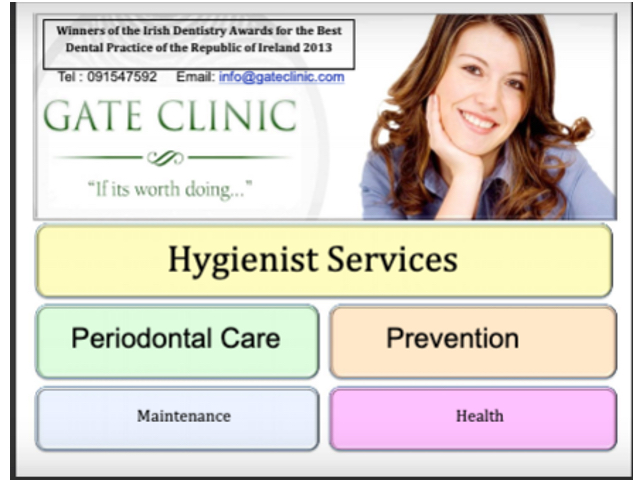
See Link to Hygienist catalogue https://www.smiles.ie/gate-dental-clinic-dentist-galway/dental-treatments/periodontal-care/dental-health-oral-hygiene/
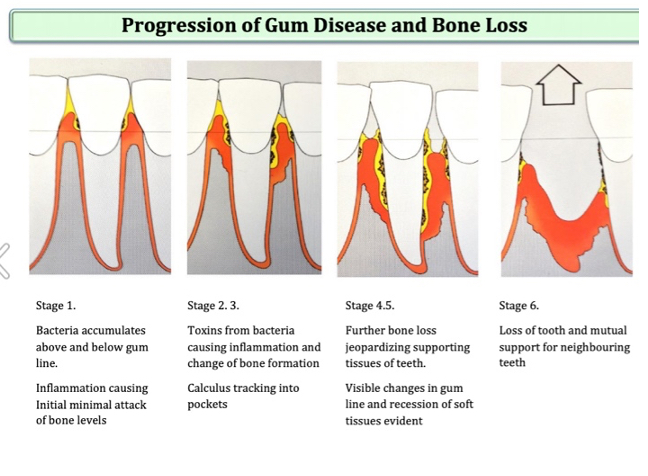
------------------------------------------------------------------------------------------------------------------------------------
Question : I’m a two times a day teeth washer and I still have bad breath. What can I do or take to save the embarrassment. Thanks.
Answer. Twice a day is great. Well done. Even so bacteria will build up in the crevices, ‘crooks and nannies” and calcify around the neck of the teeth and in the pockets and corners your toothbrush cannot reach.
There are of course some other factors, there always is, but it is this bacteria that gives you bad breath. It is often particularly noticeable in the morning because your saliva flow at night is not as good.
If you get a “scale and polish” from your hygienist it is like thoroughly weeding the garden and removes the built up bacteria that has calcified. You cannot do this with a toothbrush.
The less bacteria – the less bad breath.
Most people will benefit from seeing the hygienist twice a year. Some have to come more often.
------------------------------------------------------------------------------------------------------------------------------------
Question: My daughter is just growing her second teeth on the bottom and they appear to be quite yellow and thin. Please advise.
Answer: This one is not unusual. The new adult teeth have fine edges and can be quite sharp . Probably not something to worry about, but you would really have to see your dentist to check.
------------------------------------------------------------------------------------------------------------------------------------
Question: I had a root canal years ago and there seems to be a small hole in my gum In the general area. Is this dangerous. I’m afraid to leave the house at the moment, so what should I do?
Answer: This hole or bubble is called a “Sinus tract” and is an infection draining from the bone to the mouth.
Root canal therapy is technique to try and eliminate all the bacteria from the canal system of a root. It is not an easy thing to do 100% as the shape of the canal can be quite varied and there may be extra (lateral) canals and the tip of the root can still let bacteria fester and multiply. You can also have small cracks in the root tip.
In a nutshell if bacteria can grow in a small niche or crevice, the body reacts to this and a bubble of infection will develop and bulge through the bone at the tip of the root.
* Sometimes the dentist can re-root treat this and try and reclean the canal or canals.
* Sometimes the dentist can do a small surgery at the tip of the root to remove the infection directly and cut off the tip of the root. ( This procedure is called an apicectomy and some dentists will refer this procedure to a specialist called an “Endodontist”
See Link
* Sometimes they cannot and the tooth needs to be extracted.
It is however very important that if you see this bubble or hole in the gum you do not leave it. It is like a pressure cooker without the top on. The infection will continue to grow and can cause more serious complications the longer you leave it.
Do not be afraid to call your dentist for this. It can become a dental emergency if untreated and I would recommend you make an appointment with your dentist as soon as possible.

Link Apicectomy https://www.smiles.ie/gate-dental-clinic-dentist-galway/dental-treatments/endodontic-services/apicectomy/
Link Root canal treatment https://www.smiles.ie/gate-dental-clinic-dentist-galway/dental-treatments/endodontic-services/root-canal-treatment/
Link Cracked teeth https://www.smiles.ie/gate-dental-clinic-dentist-galway/dental-treatments/endodontic-services/cracked-teeth/

31 Comment(s)
Wonderful Blog! We appreciate you sharing this important information with us.
anabolic steroids stacks
europe casino
ottawa casino
casino oklahoma
bethlehem pa casino
https://gitea.jobiglo.com/braydenmcinnis\r\n\r\n\r\nhttps://pokesoul.com/@wiley362468654\r\n\r\n\r\nhttps://www.herzog-it.de/rogeliocadwall\r\n\r\n\r\nhttps://gitea.sguba.de/francinegoode0\r\n\r\n\r\nhttps://zurimeet.com/@adellnadeau544\r\n\r\n\r\nhttps://git.ides.club/leonory7981516\r\n\r\n\r\nhttps://git.ellinger.eu/chasrayner402/chas2006/wiki/Discover-Top-Games-and-Bonuses-in-Australia\r\n\r\n\r\nhttps://git.manabo.org/augustcalhoun5\r\n\r\n\r\nhttps://git.ecq.jp/rosalindritcha/rosalind1998/wiki/007%3A-%D0%9A%D0%B0%D0%B7%D0%B8%D0%BD%D0%BE-%D0%A0%D0%BE%D1%8F%D0%BB%D1%8C-2006-Full-cast-%26-crew\r\n\r\n\r\nhttps://gitea.ysme.top/corrineperron5\r\n\r\n\r\nhttps://gitea.svc.obaa.cloud/buddytedeschi4\r\n\r\n\r\nhttps://git.lokalix.de/alibjm28004466\r\n\r\n\r\nhttps://moonifie.com/read-blog/87090_10-best-online-casinos-in-australia-for-real-money-in-2025.html\r\n\r\n\r\nhttps://git.wisder.net/aldaashmore517\r\n\r\n\r\nhttps://hanyunmedical.com/zackscruggs282\r\n\r\n\r\nhttps://tippy-t.com/meredith35u669\r\n\r\n\r\nhttps://repo.apps.odatahub.net/catharinep433\r\n\r\n\r\nhttps://shamrick.us/aidanvgv50935\r\n\r\n\r\nhttps://gitea.tpss.top/angie76a531908\r\n\r\n\r\nhttps://nrisoulmate.com/@kieranspina516\r\n\r\n\r\nhttps://git.unpas.dev/alex41z6909700/blackcoin2334/wiki/Claim-Free-Spins-Now%21
https://shamrick.us/aidanvgv50935\r\n\r\n\r\nhttps://theavtar.in/read-blog/114322_mississippi-casinos-close-or-cut-services-due-to-winter-storm.html\r\n\r\n\r\nhttps://sistemagent.com:8081/maplehalfey833\r\n\r\n\r\nhttps://shamrick.us/mickey89w25819\r\n\r\n\r\nhttps://gogs.pinadshub.com/nolanchewning9\r\n\r\n\r\nhttps://gitea.zerova.com/billyqad561050/3314blackcoin.co/wiki/How-to-play-and-download-the-Winspirit-Casino-mobile-app%3F\r\n\r\n\r\nhttps://git.daneric.dev/tresaenyeart7/9740260/wiki/%E2%80%8ECasino-Royale-2006-directed-by-Martin-Campbell-Reviews%2C-film-+-cast\r\n\r\n\r\nhttps://successcircle.online/read-blog/14467_chow-tai-fook-probity-and-brisbane-casino-inside-the-awkward-release-of-a-alarmi.html\r\n\r\n\r\nhttps://nvuplayer.com/@marta53a49710?page=about\r\n\r\n\r\nhttps://gitlab.grupolambda.info.bo/marceloschrode\r\n\r\n\r\nhttps://git.daneric.dev/willardpaz1467/blackcoin2925/wiki/Login\r\n\r\n\r\nhttps://www.simpra.org:3000/silas36n59199/blackcoin.co1986/wiki/SkyCrown-%E0%A6%85%E0%A6%A8%E0%A6%B2%E0%A6%BE%E0%A6%87%E0%A6%A8-%E0%A6%95%E0%A7%8D%E0%A6%AF%E0%A6%BE%E0%A6%B8%E0%A6%BF%E0%A6%A8%E0%A7%8B\r\n\r\n\r\nhttps://zurimeet.com/@isobel33v26507\r\n\r\n\r\nhttps://www.jr-it-services.de:3000/scotbeich1153\r\n\r\n\r\nhttps://pleroma.cnuc.nu/russelld152505/6092blackcoin/wiki/DraftKings-Rocket%3A-What-It-Is-%26-How-To-Play\r\n\r\n\r\nhttps://wondermap.org/read-blog/8144_10-best-online-casinos-for-real-money-in-the-us-for-2025.html\r\n\r\n\r\nhttps://wiki.idealirc.org/pamshumway9320\r\n\r\n\r\nhttps://maintain.basejy.com/joeym01058650\r\n\r\n\r\nhttps://sound.gatzone.com/molliewaugh525\r\n\r\n\r\nhttps://www.lizyum.com/@montymilliman\r\n\r\n\r\nhttps://git.tbaer.de/adamvondoussa
https://git.ultra.pub/aliarkwookerum\r\n\r\n\r\nhttps://gitea.offends.cn/abbiewade13849\r\n\r\n\r\nhttps://liebiwelle.com/@margaretteblue\r\n\r\n\r\nhttps://repo.komhumana.org/mosesgoldschmi/3315blackcoin.co/wiki/%24500-Welcome-Bonus-%2B-100-Free-Spins\r\n\r\n\r\nhttps://git2.huai-yun.com/amberv72486427/9844922/wiki/Rocket-Play-Casino-Australia-Login-And-Bonuses\r\n\r\n\r\nhttps://gitea.pnkx.top:8/hiltonomd79331\r\n\r\n\r\nhttps://lekoxnfx.com:4000/lashayrendall/blackcoin.co5630/wiki/Main+casino%252C+premium+rooms+open+as+Queens+Wharf+launches\r\n\r\n\r\nhttps://git.simbarbet.com/kandiceblaze32\r\n\r\n\r\nhttps://git.cloud.leonclassroom.com/cecilcrider655/5207blackcoin.co/wiki/Best-Online-Casinos-in-Australia-Top-Casino-Sites-For-2025\r\n\r\n\r\nhttps://www.ituac.com/efrainnorris43\r\n\r\n\r\nhttps://hub.hdc-smart.com/benitoflinders/blackcoin2024/wiki/Mahnomen+Home+Minnesota+Casino%252C+Hotel+and+Event+Center+in+Mahnomen%252C+Minnesota\r\n\r\n\r\nhttps://lius.familyds.org:3000/alfonsofjx7694/blackcoin.co1997/wiki/Play-Anytime%2C-Anywhere-in-Australia%21\r\n\r\n\r\nhttps://www.lizyum.com/@angelowhitfeld\r\n\r\n\r\nhttps://gitea.fuluzhanggui.com:99/alejandraworth/blackcoin.co1987/wiki/James-Bond%3A-All-3-Casino-Royale-Adaptations-Explained\r\n\r\n\r\nhttps://git.konsulterna.nu/wallaceeagar4\r\n\r\n\r\nhttps://gitea.micro-stack.org/aidastorkey83\r\n\r\n\r\nhttps://git.slegeir.com/alecia93076317/9370blackcoin/wiki/Online-Casino-Bonuses-%26-Exclusive-Offers-for-2025\r\n\r\n\r\nhttps://www.ituac.com/venettaackerma\r\n\r\n\r\nhttps://gitea.jobiglo.com/braydenmcinnis\r\n\r\n\r\nhttps://git.daneric.dev/anhhodson82725\r\n\r\n\r\nhttps://zm.aosenhw.com/@monicacrist58
https://git.mikspec.pl/buddyfedler202/buddy1998/wiki/Best+Online+Pokies+and+Free+Spins\r\n\r\n\r\nhttps://schokigeschmack.de/newtondowdle1\r\n\r\n\r\nhttps://www.simpra.org:3000/petramcz345412\r\n\r\n\r\nhttps://hanyunmedical.com/berenicemena09\r\n\r\n\r\nhttps://music.1mm.hk/vonfeliz257204\r\n\r\n\r\nhttps://proputube.com/@gfelane576278?page=about\r\n\r\n\r\nhttps://git.ellinger.eu/ahpklara726535/5831blackcoin/wiki/Online-Gambling-in-Australia-A%244%2C000\r\n\r\n\r\nhttps://git.unpas.dev/nydiahenry6758\r\n\r\n\r\nhttps://repos.ubtob.net/guadalupefaerb\r\n\r\n\r\nhttps://testgitea.educoder.net/alexandertulab\r\n\r\n\r\nhttps://try.gogs.io/kiarasantiago7\r\n\r\n\r\nhttps://git.lakaweb.com/alinet73656444/blackcoin.co1001/wiki/The-Star-Gold-Coast-Luxury-hotel-on-the-Gold-Coast\r\n\r\n\r\nhttps://shamrick.us/vernellsauls81\r\n\r\n\r\nhttps://gogs.artapp.cn/brandenmeece65/2200blackcoin.co/wiki/Skycrown+Casino+Review+By+Experts+2025+Is+Casino+Legit+%2526+Safe%253F\r\n\r\n\r\nhttps://gogs.qindingtech.com/randelllemons\r\n\r\n\r\nhttps://www.k0ki-dev.de/adamrevell9953\r\n\r\n\r\nhttps://git.unpas.dev/nydiahenry6758\r\n\r\n\r\nhttps://sound.gatzone.com/victorinahand6\r\n\r\n\r\nhttps://git.deadpoo.net/alfredohendon2\r\n\r\n\r\nhttps://gitea.uchung.com/alicebirdsong\r\n\r\n\r\nhttps://lesla.com/@deangelohollar
https://meeting2up.it/@deondearborn9\r\n\r\n\r\nhttps://git.kirasparkle.de/annz3037189220/ann2003/wiki/Online-Pokies%2C-Mobile-Play-%26-Fast-AU%24-Withdrawals\r\n\r\n\r\nhttps://www.arabianmatrimony.com/@leroyquv324611\r\n\r\n\r\nhttps://www.simpra.org:3000/danielleclemen\r\n\r\n\r\nhttps://gogs.kakaranet.com/wallycunningha\r\n\r\n\r\nhttps://www.appleradish.org/bryantburdekin\r\n\r\n\r\nhttps://gitea.svc.obaa.cloud/bobbyef7611904\r\n\r\n\r\nhttps://social.siblia.com/read-blog/85832_gonzo-casino-no-deposit-bonus-code-2025.html\r\n\r\n\r\nhttps://git.rokiy.com/carlsigmon6330\r\n\r\n\r\nhttps://git.ecq.jp/miqueldoughart\r\n\r\n\r\nhttps://sithcom.de/marisolfrancis\r\n\r\n\r\nhttps://gitea.zerova.com/dominicksumsum\r\n\r\n\r\nhttps://git.fhlz.top/brigitte506968/1788915/wiki/RocketPlay-Online-Casino-Canada-Play-%26-Win-Real-Money\r\n\r\n\r\nhttps://otgchat.com/read-blog/8599_casino-amp-district-family-history-group-inc.html\r\n\r\n\r\nhttps://git.micahmoore.io/lenorae4026995\r\n\r\n\r\nhttps://git.lucas-michel.fr/altoncalloway\r\n\r\n\r\nhttps://lius.familyds.org:3000/helenestafford\r\n\r\n\r\nhttps://gitea.offends.cn/abbiewade13849\r\n\r\n\r\nhttps://gitea.theaken.com/agnesbirdsall\r\n\r\n\r\nhttps://onetouch-git.thxpace.com/susannedoyle03/blackcoin9654/-/issues/1\r\n\r\n\r\nhttps://shamrick.us/alysaselle4318
https://gitea.adminakademia.pl/teganlowman944\r\n\r\n\r\nhttps://zammeswiss.com/read-blog/1900_about-us-minnesota-casino-hotel-and-event-center-in-mahnomen-minnesota.html\r\n\r\n\r\nhttps://realhindu.in/read-blog/41501_expert-review-2025.html\r\n\r\n\r\nhttps://maru.bnkode.com/@abbeyu4799802\r\n\r\n\r\nhttps://hgngit.ipdz.me/lavinahemmant\r\n\r\n\r\nhttps://git.nusaerp.com/rhys2757090717/blackcoin6787/wiki/SkyCrown-Online-Casino-Best-Australian-Online-Casinos\r\n\r\n\r\nhttps://www.shwemusic.com/shelapurser072\r\n\r\n\r\nhttps://git.mikspec.pl/audreypritchar\r\n\r\n\r\nhttps://voyostars.com/read-blog/25848_skycrown-casino-review-by-experts-2025-is-casino-legit-amp-safe.html\r\n\r\n\r\nhttps://heywhatsgoodnow.com/@alexandria8805\r\n\r\n\r\nhttps://musixx.smart-und-nett.de/venusoreilly7\r\n\r\n\r\nhttps://seychelleslove.com/@antonyfredrick\r\n\r\n\r\nhttps://seychelleslove.com/@danniellemccla\r\n\r\n\r\nhttps://gitea.zerova.com/beanicoll51484/8327blackcoin.co/wiki/Crown-Coins-Casino-Review-2025-Get-100k-Free-Coins-+-2-SC\r\n\r\n\r\nhttps://git.tbaer.de/josettestainfo\r\n\r\n\r\nhttps://git.unpas.dev/alex41z6909700\r\n\r\n\r\nhttps://giteap.grobest.com:3000/armandr6501893\r\n\r\n\r\nhttps://gitea.tpss.top/buckbanning87\r\n\r\n\r\nhttps://gitlab.rails365.net/elishakaberry8\r\n\r\n\r\nhttps://zm.aosenhw.com/@jannaugle35780\r\n\r\n\r\nhttps://ophiuchus.wiki/tommiewestover
https://k0ki-dev.com/alejandrinasla\r\n\r\n\r\nhttps://qarisound.com/stormystreeton\r\n\r\n\r\nhttps://newborhooddates.com/@leliafrisina2\r\n\r\n\r\nhttps://linkspreed.web4.one/read-blog/201605_rocketplay-casino-online-in-australia-best-casino-games-for-real-money.html\r\n\r\n\r\nhttps://sensualmarketplace.com/read-blog/37952_rocketplay-casino-registration-and-login-how-to-sign-up-and-sign-in-to-your-acco.html\r\n\r\n\r\nhttps://sithcom.de/darellcarneal\r\n\r\n\r\nhttps://www.meetgr.com/@nadinebohr603\r\n\r\n\r\nhttps://lavista.kbcgroupltd.com/@adelaidewenger\r\n\r\n\r\nhttps://gitea.sguba.de/malindaboles63\r\n\r\n\r\nhttps://yooverse.com/@charitywatts96\r\n\r\n\r\nhttps://gitea.mulberrypos.ru/susanahumble38/blackcoin2019/wiki/Best-Online-Casino-Sites-Australia-2025\r\n\r\n\r\nhttps://gogs.dev.dazesoft.cn/abequintana855\r\n\r\n\r\nhttps://gitea.uchung.com/jorgkier69324\r\n\r\n\r\nhttps://gogs.qindingtech.com/elbertgower18/blackcoin2007/wiki/WinSpirit+Casino+Review+Expert+%2526+Player+Ratings+2025\r\n\r\n\r\nhttps://lius.familyds.org:3000/rose67z4750543\r\n\r\n\r\nhttps://yooverse.com/@hildegardflick\r\n\r\n\r\nhttps://www.k0ki-dev.de/lenorechiles25\r\n\r\n\r\nhttps://testgitea.educoder.net/alexandertulab\r\n\r\n\r\nhttps://gitlab.rails365.net/elishakaberry8\r\n\r\n\r\nhttps://newborhooddates.com/@nickisamson629\r\n\r\n\r\nhttps://git.thweb.net/palmawallin770
https://platform.giftedsoulsent.com/lilladegree504\r\n\r\n\r\nhttps://gitea.fuluzhanggui.com:99/bradyharmon743\r\n\r\n\r\nhttps://git.cloud.leonclassroom.com/cecilcrider655\r\n\r\n\r\nhttps://ophiuchus.wiki/bobbynewbigin4/5476392/wiki/Top-5-sweepstakes-casinos-in-November-2025%3A-Get-a-free-no-deposit-bonus-%26-more\r\n\r\n\r\nhttps://www.besolife.com/@amparorosas145\r\n\r\n\r\nhttps://hgngit.ipdz.me/vickiapplegate/vicki2021/wiki/Real-money-game-Big-Win\r\n\r\n\r\nhttps://gitea.offends.cn/kathrinhoyle95\r\n\r\n\r\nhttps://lekoxnfx.com:4000/reganjky64113\r\n\r\n\r\nhttps://gogs.optch.top/almeda31u28597\r\n\r\n\r\nhttps://sound.ukrsocial.com.ua/tillym43402626\r\n\r\n\r\nhttps://silatdating.com/@royalsmithson\r\n\r\n\r\nhttps://gitlab.innive.com/norafrost8880\r\n\r\n\r\nhttps://www.ooyy.com/read-blog/24633_skycrown-casino-online-%E1%90%89-official-login-and-registration.html\r\n\r\n\r\nhttps://gitea.pnkx.top:8/raecaro7603631\r\n\r\n\r\nhttps://gitea.ontoast.uk/alonzocooley3/blackcoin9561/wiki/Weather-and-Radar-Map-for-Ilir-Barat-Satu%2C-South-Sumatra-30131%2C-Indonesia\r\n\r\n\r\nhttps://gogs.melontalk.com.cn/candicestandle/candice2022/wiki/Secure+Access+%2526+Troubleshooting\r\n\r\n\r\nhttps://git.auwiesen2.de/aletheasiegel9\r\n\r\n\r\nhttps://git.autotion.net/cierrawss96318\r\n\r\n\r\nhttps://www.myminglemate.com/@shauntebolivar\r\n\r\n\r\nhttps://gitea.offends.cn/deanaengel8805\r\n\r\n\r\nhttps://www.oddmate.com/@adolphdeshotel
https://myhealthypunjab.com/@rosita45h34334?page=about\r\n\r\n\r\nhttps://www.simpra.org:3000/lujblair36824\r\n\r\n\r\nhttps://git.fur93.cn:8002/mervinsargent/blackcoin.co2010/wiki/10-Best-Online-Casinos-for-Real-Money-USA-in-2025\r\n\r\n\r\nhttps://karr83.world/read-blog/1557_real-money-pokies-amp-vip-rewards.html\r\n\r\n\r\nhttps://git.mopsovi.cloud/audreyrodger8\r\n\r\n\r\nhttps://hiphopmusique.com/latishackc116\r\n\r\n\r\nhttps://www.lab.justusdeitert.de/gabrielegreenw/2512705/-/issues/1\r\n\r\n\r\nhttps://git.konsulterna.nu/drusilla86866\r\n\r\n\r\nhttps://www.fastmarry.com/@alannafaulk746\r\n\r\n\r\nhttps://koseongnam.com/aleisha15n795\r\n\r\n\r\nhttps://git.fhlz.top/cathernmagoffi\r\n\r\n\r\nhttps://gitea.visoftware.com.co/amandadurbin2\r\n\r\n\r\nhttps://scrape.weidautzel.de/aidenangas4419\r\n\r\n\r\nhttps://repo.komhumana.org/launam84868980\r\n\r\n\r\nhttps://myhealthypunjab.com/@rosita45h34334?page=about\r\n\r\n\r\nhttps://git.rec4box.com/aishayrl639417\r\n\r\n\r\nhttps://lesla.com/@cooper57300778\r\n\r\n\r\nhttps://gitea.sguba.de/pbckandace1615\r\n\r\n\r\nhttps://git.unicom.studio/birgithooley55\r\n\r\n\r\nhttps://git.outsidecontext.solutions/bessiemcgarry3/4798blackcoin.co/wiki/Enchanting-Ventures-in-the-Realm-of-WS-Casino\r\n\r\n\r\nhttps://git.daoyoucloud.com/albertinap4122/blackcoin.co1988/wiki/Sky-Crown-Online-Casino-Slots%2C-Tables-%26-Live-Dealers
https://mardplay.com/cedricbuffingt\r\n\r\n\r\nhttps://gogs.greta.wywiwyg.net/berndillingwor\r\n\r\n\r\nhttps://omayaa.com/read-blog/6389_rocketplay-online-casino-in-australia-with-real-money-games.html\r\n\r\n\r\nhttps://qarisound.com/stormystreeton\r\n\r\n\r\nhttps://meetme.goo.ng/@alba339105844\r\n\r\n\r\nhttps://sound.descreated.com/lavonnestelzer\r\n\r\n\r\nhttps://ophiuchus.wiki/reaganfoerster\r\n\r\n\r\nhttps://loveis.app/@efrenelam00218\r\n\r\n\r\nhttps://gogs.optch.top/brock65i930072\r\n\r\n\r\nhttps://git.ecq.jp/nolangdh67408/9415blackcoin.co/wiki/Official-Site-For-Aussies-2025\r\n\r\n\r\nhttps://pleroma.cnuc.nu/barryseeley23\r\n\r\n\r\nhttps://gitea.micro-stack.org/loreen26j1753/loreen1997/wiki/SkyCrown-Live-Casino%3A-Authentic-Online-Gaming-with-Pro-Dealers\r\n\r\n\r\nhttps://www.muslimlove.com/@melinalanham2\r\n\r\n\r\nhttps://gitea.theaken.com/ramonitaagg914\r\n\r\n\r\nhttps://git.mklpiening.de/alfieyar962870\r\n\r\n\r\nhttps://hipstrumentals.net/larryhaszler35\r\n\r\n\r\nhttps://oroluck.com/read-blog/2223_crown-coins-casino-games-best-games-at-crown-coins.html\r\n\r\n\r\nhttps://gitea.jasonstolle.com/erickveal26593/8371723/wiki/Casino-Travel-guide-at-Wikivoyage\r\n\r\n\r\nhttps://musixx.smart-und-nett.de/kassiemccloske\r\n\r\n\r\nhttps://ralphouensanga.com/read-blog/54930_new-south-wales-online-casinos-2025.html\r\n\r\n\r\nhttps://git.autotion.net/cierrawss96318
https://godscoop.com/read-blog/40259_online-pokies-bonuses-amp-guides.html\r\n\r\n\r\nhttps://gogs.dev.dazesoft.cn/roryl486692646\r\n\r\n\r\nhttps://git.simbarbet.com/hildegardthoms/hildegard2013/wiki/Best-Online-Casinos-in-Australia-Top-Casino-Sites-For-2025\r\n\r\n\r\nhttps://gitea.zerova.com/acqodell01984\r\n\r\n\r\nhttps://gogs.gaokeyun.cn/deborahgain95\r\n\r\n\r\nhttps://git.camus.cat/desiree97g434\r\n\r\n\r\nhttps://www.jokkey.com/horacio44r9114\r\n\r\n\r\nhttps://scrape.weidautzel.de/domingaackley1\r\n\r\n\r\nhttps://git.gaminganimal.org/georgiakeysor\r\n\r\n\r\nhttps://gitea.mocup.org/hortensebecket\r\n\r\n\r\nhttps://gitea.sguba.de/ykncollette017\r\n\r\n\r\nhttps://sistemagent.com:8081/arnoldfitzwate\r\n\r\n\r\nhttps://kamtk.ru:4000/louisacharles3\r\n\r\n\r\nhttps://worship.com.ng/sylvialarnach1\r\n\r\n\r\nhttp://123.132.248.154:10000/edmundotoney6/2640912/wiki/Official-Site-in-CA\r\n\r\n\r\nhttps://gitea.sguba.de/astridkruttsch\r\n\r\n\r\nhttps://music.michaelmknight.com/michalparkman0\r\n\r\n\r\nhttps://git0.zpqrtbnk.net/pedrofreed2927/blackcoin8765/wiki/Play-Real-Money-Casino-Games\r\n\r\n\r\nhttp://www.controlleriot.cn:3000/linniesmi44907\r\n\r\n\r\nhttps://git.fur93.cn:8002/ryders7038465\r\n\r\n\r\nhttps://git.scene.to/adrianaowl166
https://video.cheeft.com/@adriannastreet?page=about\r\n\r\n\r\nhttps://liebiwelle.com/@domeniclight6\r\n\r\n\r\nhttps://img.lodis.se/adolphbinns87\r\n\r\n\r\nhttps://git.rankenste.in/xwkdorine30935\r\n\r\n\r\nhttp://guanli.jiance.cn:3000/arnoldolawes50\r\n\r\n\r\nhttps://quenly.com/@jarrodsievier\r\n\r\n\r\nhttps://srsbkn.eu.org/wilburbothwell\r\n\r\n\r\nhttps://gitstud.cunbm.utcluj.ro/natashareeve92/blackcoin.co2872/-/issues/1\r\n\r\n\r\nhttps://music.michaelmknight.com/rochellmoney32\r\n\r\n\r\nhttps://stevewpalmer.uk/mammie49g92902\r\n\r\n\r\nhttps://seychelleslove.com/@debgilreath937\r\n\r\n\r\nhttps://git.nightime.org/brittnyragsdal\r\n\r\n\r\nhttps://www.first315.com/mollieexf41182/blackcoin.co6902/wiki/Best+Online+Live+Casinos+2025+Play+at+the+Top+US+Live+Casinos\r\n\r\n\r\nhttps://git.mista.ru/mayawaterhouse\r\n\r\n\r\nhttps://music.michaelmknight.com/rochellmoney32\r\n\r\n\r\nhttps://git.olyntec.com/alyciawaley227\r\n\r\n\r\nhttps://virasocia.ca/read-blog/2734_skycrown-a-a-yoa-ia-%D1%95a-a-yo-a-a-%D1%9Ca-yia-%D1%95a-yoa-yia-yoa.html\r\n\r\n\r\nhttps://umkmjuara.id/read-blog/3052_rocketplay-casino-australia-best-rocket-play-online-casino-for-real-money-austra.html\r\n\r\n\r\nhttps://rc.intaps.com/sheila42119876\r\n\r\n\r\nhttps://lekoxnfx.com:4000/edithdyett5747\r\n\r\n\r\nhttps://gitea.fuluzhanggui.com:99/alejandraworth/blackcoin.co1987/wiki/Crown-Casino
https://lekoxnfx.com:4000/edithdyett5747\r\n\r\n\r\nhttps://zm.aosenhw.com/@kurtluevano495\r\n\r\n\r\nhttps://giteap.grobest.com:3000/armandr6501893\r\n\r\n\r\nhttps://www.ooyy.com/read-blog/24653_cassino-lazio-italy-weather-forecast.html\r\n\r\n\r\nhttps://repo.apps.odatahub.net/mattiecowan13\r\n\r\n\r\nhttps://pilowtalks.com/@albertinagarre\r\n\r\n\r\nhttps://gogs.gaokeyun.cn/michaljunker98\r\n\r\n\r\nhttps://home.zhupei.me:3000/anastasiacarl\r\n\r\n\r\nhttps://zurimeet.com/@mckenzietinche\r\n\r\n\r\nhttps://motion-nation.com/read-blog/2776_luxury-gaming-hotel-dining-amp-entertainment.html\r\n\r\n\r\nhttps://git.nusaerp.com/adam797485758/9089blackcoin.co/wiki/Top-Online-Casinos-in-Australia-2025-AUS-Real-Money-Sites\r\n\r\n\r\nhttps://git.ecq.jp/adalombardo024\r\n\r\n\r\nhttp://gitea.liaozhuangkeji.com/francescovando\r\n\r\n\r\nhttps://net.smartedge.com.ng/read-blog/9890_richard-casino-review-no-deposit-bonus-30-free-spins.html\r\n\r\n\r\nhttps://matchpet.es/@laylanothling\r\n\r\n\r\nhttps://git.ajattix.org/calebdaj82496\r\n\r\n\r\nhttps://git.hanckh.top/katlynanivitti\r\n\r\n\r\nhttps://scrape.weidautzel.de/domingaackley1\r\n\r\n\r\nhttps://git.kitti.ac.th/darrylpedley6/blackcoin.co2022/wiki/Sign-In-To-Fair-Go-Casino-For-Fast-Bonus-Access-Today\r\n\r\n\r\nhttps://intalnirisecrete.ro/@lzrchang455072\r\n\r\n\r\nhttps://git.lolpro11.me/borismichels5/1856blackcoin.co/wiki/US-Players-Accepted%21
https://healedonly.com/@jackiewhitaker\r\n\r\n\r\nhttps://lavista.kbcgroupltd.com/@alexandriadear\r\n\r\n\r\nhttps://git.sjurtf.net/rosiegoldberg7\r\n\r\n\r\nhttps://www.simpra.org:3000/christenawilke\r\n\r\n\r\nhttps://syq.im:2025/alannairving14/2841655/wiki/Rocket-Play-Casino-No-Deposit-Bonus-2025-%3A-Get-50-Free-Spins\r\n\r\n\r\nhttps://onetouch-git.thxpace.com/lynnebladin061\r\n\r\n\r\nhttps://git.slegeir.com/jon5619623413\r\n\r\n\r\nhttps://git.barsisr.fr/berryhcr10022\r\n\r\n\r\nhttps://www.first315.com/quentinb257675\r\n\r\n\r\nhttps://worship.com.ng/joycemky166594\r\n\r\n\r\nhttps://zm.aosenhw.com/@craigelsey5287\r\n\r\n\r\nhttps://www.simpra.org:3000/rosemarycolley\r\n\r\n\r\nhttps://lab.nltvc.com/jeanauxw50245\r\n\r\n\r\nhttps://www.first315.com/faustolampe24/blackcoin.co2022/wiki/CrownCoins+Casino+Promo+Code%253A+1+5M+Crown+Coins+++75+SC+Bonus\r\n\r\n\r\nhttps://gitea.coderpath.com/adrienesheets\r\n\r\n\r\nhttps://quickdatescript.com/@antoniettagibl\r\n\r\n\r\nhttps://liebiwelle.com/@domeniclight6\r\n\r\n\r\nhttps://jenkins.txuki.duckdns.org/bettie61s48882\r\n\r\n\r\nhttps://git.unicom.studio/lesleyshelton4\r\n\r\n\r\nhttps://git.ezmuze.co.uk/gertrudebaldwi\r\n\r\n\r\nhttps://talkkro.com/read-blog/7040_online-pokies-mobile-play-amp-fast-au-withdrawals.html
https://www.meetgr.com/@amandalarnach\r\n\r\n\r\nhttps://www.fastmarry.com/@adelehain53977\r\n\r\n\r\nhttps://kayesbamusic.com/tahlialair5809\r\n\r\n\r\nhttps://vcs.int.feuerwehr-ziemetshausen.de/celinadyason16\r\n\r\n\r\nhttps://www.appleradish.org/antoinehoneycu\r\n\r\n\r\nhttps://www.superphage.org/saulworthingto\r\n\r\n\r\nhttps://koseongnam.com/etsukokeartlan\r\n\r\n\r\nhttps://repo.komhumana.org/merrysutherlan\r\n\r\n\r\nhttps://git.getmind.cn/alfredtunstall\r\n\r\n\r\nhttps://godscoop.com/read-blog/40259_online-pokies-bonuses-amp-guides.html\r\n\r\n\r\nhttps://gitlab.edebe.com.br/octaviasamuel4\r\n\r\n\r\nhttps://music.michaelmknight.com/rochellmoney32\r\n\r\n\r\nhttps://gitlab.jmarinecloud.com/dessieflinders\r\n\r\n\r\nhttps://gitea.coderpath.com/alishajelks56/9452331/wiki/Play-19%2C430+-Free-Slot-Games-98-5%25-RTP-No-Download\r\n\r\n\r\nhttps://fyahtrak.com/damieni7821173\r\n\r\n\r\nhttps://repo.apps.odatahub.net/fphandrea25808/1419690/wiki/Claim-up-to-AU$7%2C500-+-550-Free-Spins-welcome-bonus-now\r\n\r\n\r\nhttps://lesla.com/@carmelodilke68\r\n\r\n\r\nhttps://git.mista.ru/adolfobaeza612\r\n\r\n\r\nhttps://git.koppa.pro/alphonsomaxie\r\n\r\n\r\nhttp://kpro.shanghaiopen.org.cn:8005/carla487308016/carla1982/wiki/Top-Sites-for-2025\r\n\r\n\r\nhttps://unillel-paraversum.de/milla25i199347
https://deaddeaddead.store/lorikramer7684\r\n\r\n\r\nhttps://www.first315.com/mollieexf41182/blackcoin.co6902/wiki/Best+Online+Live+Casinos+2025+Play+at+the+Top+US+Live+Casinos\r\n\r\n\r\nhttps://volts.howto.co.ug/@brady680696540\r\n\r\n\r\nhttps://gitea.nongnghiepso.com/naomijackman25/naomi2019/wiki/The-Best-Online-Casino-Choices-in-Australia\r\n\r\n\r\nhttps://ljs.fun:19000/adrianna35o806/blackcoin.co2022/wiki/Delve-into-the-Thrilling-Universe-of-the-WS-Casino-App-Dees-%26-Tees-Unleash-Your-Style\r\n\r\n\r\nhttps://gitea.coderpath.com/alishajelks56/9452331/wiki/Play-19%2C430+-Free-Slot-Games-98-5%25-RTP-No-Download\r\n\r\n\r\nhttps://git.ellinger.eu/aleidastradbro/blackcoin.co1988/wiki/Mobile-App-Instant-Play-Online-Pokies-Free-Spins-Tournaments-No-Deposit-Bonus-Codes-2025-Promo-Coupons-FairGoPlus\r\n\r\n\r\nhttps://jenkins.txuki.duckdns.org/alphonsohinson\r\n\r\n\r\nhttps://gitea.ysme.top/flossiekellow9\r\n\r\n\r\nhttps://gitea.xtometa.com/rozellablair76\r\n\r\n\r\nhttps://www.oddmate.com/@frankier670674\r\n\r\n\r\nhttps://omayaa.com/read-blog/6401_fair-go-casino-free-chip-codes-july-2025-bonus-update.html\r\n\r\n\r\nhttps://gogs.gaokeyun.cn/michaljunker98\r\n\r\n\r\nhttps://rc.intaps.com/franklinqso586/blackcoin.co7632/wiki/Best-Online-Casino-for-Aussies\r\n\r\n\r\nhttps://www.nxgit.xyz/alannahbejah76\r\n\r\n\r\nhttps://gogs.artapp.cn/dericksceusa58\r\n\r\n\r\nhttps://gitea.sguba.de/astridkruttsch\r\n\r\n\r\nhttps://vila.go.ro/anyajackson75\r\n\r\n\r\nhttps://gitea.kdlsvps.top/alejandrinahar/1125848/wiki/King-Billy-Casino-Free-Bonus-Codes-No-Deposit-Required\r\n\r\n\r\nhttps://gogs.dev.dazesoft.cn/wadearmitage32\r\n\r\n\r\nhttps://kayesbamusic.com/tahlialair5809
http://dodo00.dothome.co.kr/bbs/board.php?bo_table=1_2&wr_id=350387\r\n\r\n\r\nhttp://www.career4.co.kr/bbs/board.php?bo_table=ci_consulting&wr_id=307428\r\n\r\n\r\nhttps://cuttify.io/jackie57i29905\r\n\r\n\r\nhttps://somalibidders.com/employer/the-star-entertainment-group-asxsgr-stock-price-overview/\r\n\r\n\r\nhttps://storiediviaggio.com/kelvindoris549\r\n\r\n\r\nhttp://www.129koreaems.com/bbs/board.php?bo_table=free&wr_id=11\r\n\r\n\r\nhttps://centerdb.makorang.com:443/bbs/board.php?bo_table=qa&wr_id=80709\r\n\r\n\r\nhttps://skillrizen.com/profile/jorjatheriault\r\n\r\n\r\nhttps://url9xx.com/rashad36048003\r\n\r\n\r\nhttp://jobs.recruithub.africa/profile/flynnmcgarry26\r\n\r\n\r\nhttps://msgtechzone.com/indianabreedlo\r\n\r\n\r\nhttps://bmp.pw/jasminmccarthy\r\n\r\n\r\nhttps://beshortlisted.com/employer/gold-coast-hotel-and-casino-map-2024/\r\n\r\n\r\nhttp://www.leeonespa.com/bbs/board.php?bo_table=free&wr_id=84\r\n\r\n\r\nhttps://bilzainvisa.com/employer/kingbillywin-casino-login-and-registration-in-australia/\r\n\r\n\r\nhttps://fresherskiduniya.com/employer/cairns-queensland-casinos/\r\n\r\n\r\nhttp://mjf.xn--hy1b90it0ofnk.com/bbs/board.php?bo_table=free&wr_id=180405\r\n\r\n\r\nhttp://makeshare.org/bbs/board.php?bo_table=news&wr_id=99\r\n\r\n\r\nhttps://employmentabroad.com/companies/sgr-asx-star-shares-to-remain-suspended-until-deal-with-unnamed-investor/\r\n\r\n\r\nhttps://sondevs.com/KwTjs\r\n\r\n\r\nhttps://employmentabroad.com/companies/sgr-asx-star-shares-to-remain-suspended-until-deal-with-unnamed-investor/
https://europejobs.cloud/companies/live-casino-play-with-real-dealers-win-big/\r\n\r\n\r\nhttps://remoteaijobs.ai/employer/cashman-casino-free-coins-november-2025/\r\n\r\n\r\nhttps://www.dynamicviewpoint.co.uk/employer/21bit-free-spins-get-the-best-free-spin-bonuses-at-21bit-casino/\r\n\r\n\r\nhttps://seoulthegowoon.com/bbs/board.php?bo_table=free&wr_id=488888\r\n\r\n\r\nhttps://fs-biolink.com/alexandriachri\r\n\r\n\r\nhttp://geokofola.geopivko.cz/forum/profile/vernonwhiddon55/\r\n\r\n\r\nhttp://www.xn--3e0bl91azmcnwkspav10e.com/bbs/board.php?bo_table=free&wr_id=17\r\n\r\n\r\nhttp://www.affair.co.kr/bbs/board.php?bo_table=free&wr_id=556936\r\n\r\n\r\nhttps://built.molvp.net/patricepen\r\n\r\n\r\nhttps://analyticsjobs.in/jobs/companies/list-of-casinos-in-australia-top-au-gambling-venues-2025/\r\n\r\n\r\nhttp://www.129koreaems.com/bbs/board.php?bo_table=free&wr_id=7\r\n\r\n\r\nhttps://urlb.link/mitzi39588122\r\n\r\n\r\nhttp://www.toilland.com/bbs/board.php?bo_table=free&wr_id=59381\r\n\r\n\r\nhttps://xqr.ai/yasminschm\r\n\r\n\r\nhttps://trlink.me/karmaosbur\r\n\r\n\r\nhttps://ah.my/sylvesterstrut\r\n\r\n\r\nhttps://www.belizetalent.com/employer/national-casino-2025-review-of-bonuses-games-and-payments/\r\n\r\n\r\nhttps://vagas.grupooportunityrh.com.br/employer/joe-fortune-casino-test-real-money-games-for-australian-in-2025/\r\n\r\n\r\nhttps://avyc.io/jbncassie16875\r\n\r\n\r\nhttps://sosjob.ca/employer/binary-wins-infinite-possibilities/\r\n\r\n\r\nhttps://creationsmanpower.com/employer/lucky-ones-reviews-read-customer-service-reviews-of-www-luckyones-com/
random number generator online\r\n\r\n\r\nhttps://minilink.nl/kathie4790830 https://minilink.nl/\r\n\r\n\r\nhttps://emploi-securite.com/societes/king-billy-casino-casino-review-expert-analysis-based-on-12-criteria/ emploi-securite.com\r\n\r\n\r\nhttps://youlink.biz/verlaimq61351 https://youlink.biz\r\n\r\n\r\nhttp://www.129koreaems.com/bbs/board.php?bo_table=free&wr_id=8 http://www.129koreaems.com/bbs/board.php?bo_table=free&wr_id=8\r\n\r\n\r\nhttps://careeredupersonnel.com/employer/joe-fortune-casino/ https://careeredupersonnel.com/employer/joe-fortune-casino/\r\n\r\n\r\nhttps://cyltalentohumano.com/employer/kingbillywin-casino-login-and-registration-in-australia/ https://cyltalentohumano.com\r\n\r\n\r\nhttps://short.vird.co/adrieneweindor https://short.vird.co\r\n\r\n\r\nhttps://talentlinkjobs.co.uk/companies/casino-table-games-at-king-billy-play-for-real-money/ https://talentlinkjobs.co.uk/\r\n\r\n\r\nhttps://taradmai.com/profile/terri000477334 taradmai.com\r\n\r\n\r\nhttps://fanajobs.com/profile/janettenyo5707 fanajobs.com\r\n\r\n\r\nhttps://koftc.com/bbs/board.php?bo_table=free&wr_id=16 https://koftc.com/bbs/board.php?bo_table=free&wr_id=16\r\n\r\n\r\nhttps://seven.mixh.jp/answer/question/best-casino-hotels-in-beijing-your-ultimate-gaming-guide https://seven.mixh.jp/\r\n\r\n\r\nhttps://abtl.ink/rosellashu abtl.ink\r\n\r\n\r\nhttps://apollo2b.com/zorkayleigh063 apollo2b.com\r\n\r\n\r\nhttp://www.pottomall.com/bbs/board.php?bo_table=free&wr_id=5696819 www.pottomall.com\r\n\r\n\r\nhttps://viptube.site/delila96c3399 viptube.site\r\n\r\n\r\nhttps://apollo2b.com/louveniadennis https://apollo2b.com\r\n\r\n\r\nhttps://jobsharmony.com/companies/best-online-casinos-for-real-money-in-the-us-top-casino-sites/ https://jobsharmony.com
las vegas casinos list\r\n\r\n\r\nhttps://emploi-securite.com/societes/joe-fortune-casino/ emploi-securite.com\r\n\r\n\r\nhttps://getshort.in/king449295949 https://getshort.in/king449295949\r\n\r\n\r\nhttps://www.jw-test.com/bbs/board.php?bo_table=free&wr_id=341 www.jw-test.com\r\n\r\n\r\nhttps://karierainsports.gr/employer/400-bonus-australia-login/ karierainsports.gr\r\n\r\n\r\nhttps://www.jssystems.co.kr/bbs/board.php?bo_table=free&wr_id=36619 www.jssystems.co.kr\r\n\r\n\r\nhttps://cute.link/chancetonkin4 https://cute.link/\r\n\r\n\r\nhttps://www.paknaukri.pk/companies/21bit-casino-no-deposit-bonuses-20-free-spins-elvis-frog-in-vegas/ https://www.paknaukri.pk/\r\n\r\n\r\nhttps://audiorooms-radio.de/zacpell2852831 audiorooms-radio.de\r\n\r\n\r\nhttps://urbanplannerjobs.com/employer/joe-fortune-casino-test-real-money-games-for-australian-in-2025/ https://urbanplannerjobs.com/employer/joe-fortune-casino-test-real-money-games-for-australian-in-2025\r\n\r\n\r\nhttps://alstr.in/xchrichelle909 https://alstr.in/\r\n\r\n\r\nhttps://cannabisjobs.solutions/companies/rocket-play-casino-review-no-deposit-bonuses-2025/ https://cannabisjobs.solutions/companies/rocket-play-casino-review-no-deposit-bonuses-2025\r\n\r\n\r\nhttps://jobteck.com.sg/companies/sgr-asx-star-entertainment-gives-salter-brothers-deal-deadline/ jobteck.com.sg\r\n\r\n\r\nhttp://www.leeonespa.com/bbs/board.php?bo_table=free&wr_id=77 leeonespa.com\r\n\r\n\r\nhttps://searl.co/pilarc47311025 searl.co\r\n\r\n\r\nhttp://xn--oi2by7cw7pc5j9kf.com/bbs/board.php?bo_table=free&wr_id=5395 oi2by7cw7pc5j9kf.com\r\n\r\n\r\nhttps://flubber.pro/rosalynmarquez flubber.pro\r\n\r\n\r\nhttps://wiyoung.com/anthonyfrantz1 wiyoung.com\r\n\r\n\r\nhttps://empleosrapidos.com/companies/the-ville-resort-casino-194-townsville-hotel-deals-reviews/ https://empleosrapidos.com/companies/the-ville-resort-casino-194-townsville-hotel-deals-reviews/
https://winacess.com/employer/13971/lucky-ones-casino-lucky-ones-casino-australia-lucky-ones-login\r\n\r\n\r\nhttps://superlinktree.com/amberembli\r\n\r\n\r\nhttps://www.sitiosbolivia.com/author/jasminebuck/\r\n\r\n\r\nhttps://icskorea.co.kr/bbs/board.php?bo_table=free&wr_id=516659\r\n\r\n\r\nhttps://infolokerbali.com/employer/gold-coast-hotel-and-casino/\r\n\r\n\r\nhttps://savg.in/dyanlnp5395651\r\n\r\n\r\nhttps://msgtechzone.com/leticiasettle\r\n\r\n\r\nhttps://hmljobs.com/employer/2277/site-map\r\n\r\n\r\nhttps://chaakri.com/employer/the-reef-hotel-casino-cairns/\r\n\r\n\r\nhttps://pgsssirsi.com/companies/ozwin-casino-login-registration-access-real-bonuses-today/\r\n\r\n\r\nhttps://walo.vip/dalenelawlor62\r\n\r\n\r\nhttps://www.bookmyaccountant.co/profile/garfielddowlin\r\n\r\n\r\nhttps://linkplatoon.com/carrolsutt\r\n\r\n\r\nhttps://prabeshgroup.pl/employer/premier-online-gaming-platform/\r\n\r\n\r\nhttps://madeinna.org/profile/wtvbryon85527\r\n\r\n\r\nhttps://jobs.sharedservicesforum.in/employers/15-best-online-casinos-australia-2025-real-money-casino-sites/\r\n\r\n\r\nhttps://pagemelon.com/dglcharley\r\n\r\n\r\nhttp://www.romantic100.co.kr/bbs/board.php?bo_table=free&wr_id=11\r\n\r\n\r\nhttp://www.career4.co.kr/bbs/board.php?bo_table=ci_consulting&wr_id=307390\r\n\r\n\r\nhttps://seeurl.site/mariceladoolet\r\n\r\n\r\nhttps://quicklancer.bylancer.com/profile/sabineybarra7
the meadows racetrack and casino\r\n\r\n\r\nhttps://grupokandidat.com/compa%C3%B1ias/premium-slots-live-dealers-elite-rewards/ grupokandidat.com\r\n\r\n\r\nhttps://www.iqconsult.pro/employer/best-real-money-online-casinos-australia-2025-updated-list/ www.iqconsult.pro\r\n\r\n\r\nhttps://infinitystaffingsolutions.com/employer/the-best-crypto-casino-for-new-zealand-players/ https://infinitystaffingsolutions.com/employer/the-best-crypto-casino-for-new-zealand-players/\r\n\r\n\r\nhttps://portalwe.net/employer/top-online-casinos-usa-play-for-real-money-today/ portalwe.net\r\n\r\n\r\nhttps://taradmai.com/profile/terri000477334 https://taradmai.com/profile/terri000477334\r\n\r\n\r\nhttps://mapnova.com.co/employer/rocket-play-casino-no-deposit-bonus-australia-november-2025/ mapnova.com.co\r\n\r\n\r\nhttps://hirekaroo.com/companies/star-entertainment-keeps-sydney-casino-open-but-fined-again/ https://hirekaroo.com/companies/star-entertainment-keeps-sydney-casino-open-but-fined-again/\r\n\r\n\r\nhttp://ttceducation.co.kr/bbs/board.php?bo_table=free&wr_id=3029591 ttceducation.co.kr\r\n\r\n\r\nhttps://grupokandidat.com/compa%C3%B1ias/premium-slots-live-dealers-elite-rewards/ grupokandidat.com\r\n\r\n\r\nhttps://invitation.link/earthasant invitation.link\r\n\r\n\r\nhttps://ethiofarmers.com/claim-your-generous-welcome-bonus-at-ozwin-casino/ ethiofarmers.com\r\n\r\n\r\nhttps://1page.bio/royalrubin 1page.bio\r\n\r\n\r\nhttps://primestaff.ca/employer/gold-coast/ primestaff.ca\r\n\r\n\r\nhttps://www.easy2france.com/employer/play-real-money-games-online-win-big-daily/ easy2france.com\r\n\r\n\r\nhttps://trlink.org/walterquis https://trlink.org/\r\n\r\n\r\nhttps://jobsahi.com/employer/best-real-money-australian-online-casino-sites-for-2025/ https://jobsahi.com\r\n\r\n\r\nhttps://healthcarejobies.com/employer/best-real-money-online-casinos-australia-2025-updated-list/ https://healthcarejobies.com/employer/best-real-money-online-casinos-australia-2025-updated-list/\r\n\r\n\r\nhttps://bio66.site/marilouqvh6325 https://bio66.site/marilouqvh6325
https://cuttify.io/margotboling13\r\n\r\n\r\nhttp://sesimmaeul.co.kr/bbs/board.php?bo_table=free&wr_id=908\r\n\r\n\r\nhttps://prabeshgroup.pl/employer/premier-online-gaming-platform/\r\n\r\n\r\nhttps://stroijobs.com/employer/national-casino-legit-review-2025/\r\n\r\n\r\nhttp://copya.co.kr/bbs/board.php?bo_table=free&wr_id=505626\r\n\r\n\r\nhttps://careers.tu-varna.bg/employer/the-star-sydney/\r\n\r\n\r\nhttps://woodybiz.com/aubreyclayton4\r\n\r\n\r\nhttp://www.affair.co.kr/bbs/board.php?bo_table=free&wr_id=556765\r\n\r\n\r\nhttps://kaykarbar.com/companies/rocketplay-casino-bonuses-no-deposit-bonus-codes-november-2025/\r\n\r\n\r\nhttps://www.milegajob.com/companies/king-billy-casino-login-australia-play-over-5000-games-and-claim-your-a2500-250-free-spins/\r\n\r\n\r\nhttps://cvcentrum.eu/companies/the-star-asx-sgr-suspended-over-accounts-failure-with-administration-on-the-cards/\r\n\r\n\r\nhttps://kor.fromkorea.kr/bbs/board.php?bo_table=free&wr_id=3029\r\n\r\n\r\nhttps://qr.nukkun.com/coraeddy58\r\n\r\n\r\nhttps://sosi.al/jolenestrub991\r\n\r\n\r\nhttp://biz.godwebs.com/bbs/board.php?bo_table=free&wr_id=269171\r\n\r\n\r\nhttp://copya.co.kr/bbs/board.php?bo_table=free&wr_id=505626\r\n\r\n\r\nhttps://maridin.tr/profile/gingercambage9\r\n\r\n\r\nhttps://analyticsjobs.in/jobs/companies/21bit-free-spins-get-the-best-free-spin-bonuses-at-21bit-casino/\r\n\r\n\r\nhttp://poderdiario.com/cathernbalmain\r\n\r\n\r\nhttp://www.ardenneweb.eu/archive?body_value=%3C/p%3E%3Cbr%3E+%3Cbr%3E++%3Cp%3EThe+Ville+Casino+operates+under+the+licensing+and+regulatory+guidelines+of+the+Queensland+Office+of+Liquor+and+Gaming+Regulation.+This+ensures+that+the+casino+meets+all+legal+requirements+for+fair+gaming+and+responsible+service.+Compliance+with+these+regulations+is+mandatory+for+operating+in+Australia%2C+guaranteeing+a+safe+and+regulated+environment+for+players.+Our+range+of+classics+include+Blackjack%2C+Roulette%2C+Mini+Baccarat%2C+Three+Card%2C+Caribbean+Stud%2C+the+Ville+Wheel%2C+Casino+War+as+well+as+automated+table+games+Vegas+Star+plus+The+Ville+Wheel+will+be+returning+soon%21%3Cbr%3E+%3Cbr%3E++However%2C+unlike+Vegas%2C+casinos+are+more+than+just+about+the+gamble+in+Townsville.+It%27s+about+soaking+in+the+views+from+your+luxury+suite+after+a+night+of+fun+and+games.+The+bars+are+home+to+live+music+and+special+events+so+there%E2%80%99s+always+some+form+of+entertainment+going+on.%3Cbr%3E+%3Cbr%3E++The+Computershare+chairman%E2%80%99s+Colonial+Leisure+Group+entered+into+an+agreement+to+buy+Echo+Entertainment+Group+%E2%80%99s+Jupiters+Townsville+casino+for+$70+million+in+January.+Townsville%E2%80%99s+waterfront+skyline+has+changed+dramatically+over+the+past+decade%2C+and+much+of+that+evolution+is+thanks+to+the+transformational+efforts+of+The+Ville+Resort-%3Ca+href%3D%22https://blackcoin.co/best-bitcoin-casinos-gambling-sites-top-picks-ranked-reviewed/%22%3Ebitcoin+casino+wagering+requirements%3C/a%3E%2C+Ardo%2C+and+their+parent+company%2C+Morris+Group.+Under+the+stewardship+of+founder+Chris+Morris+and+an+ambitious+executive+team%2C+these+properties+are+redefining+hospitality+in+North+Queensland%E2%80%94elevating+it+to+a+new+echelon+of+luxury%2C++%3CA+HREF%3D%22https://blackcoin.co/victor96-your-ultimate-entertainment-destination-1-gaming-hub-in-australia/%22%3EVictor+96+best+online+slots%3C/A%3E+community+engagement%2C+and+regional+pride.+According+to+the+Australian+Financial+Review%2C+the+net+worth+of+Chris+Morris+is+around+$1.02+billion.+He+made+his+wealth+and+name+in+technology+as+a+co-founder+of+the+share+registry+business+Computershare.%3Cbr%3E+%3Cbr%3E++As+such%2C+tourists+or+citizens+went+to+Townsville+only+to+play+%3Ca+href%3D%22https://blackcoin.co/best-online-casinos-in-australia-for-real-money-2025-10/%22%3Etop+real+money+casino+AU+2026%3C/a%3E+games+because+the+food+and+beverage+offerings+were+way+too+average.+Only+after+being+obtained+by+Colonial+Leisure+Group+and+Chris+Morris+did+this+place+begin+to+develop+in+other+areas+as+well%2C+becoming+a+leading+regional+resort+with+quality+service.+The+second+largest+casino+in+Townsville+would+be+Kirwan+Tavern+with+45+gaming+machines+/+table+games.+If+you+wish+to+make+lodging+accommodations+at+Kirwan+Tavern%2C+please+visit+the+Kirwan+Tavern+information+page+for+more+details.+The+largest+casino+in+Townsville%2C+Queensland+according+to+gaming+machines+and+table+games+put+together%2C+is+Ville+Resort+%26amp;+Casino.+The+Ville+Resort+%26amp;+Casino+total+casino+square+footage+is+54%2C800+square+feet.%3Cbr%3E+%3Cbr%3E++This+premium+service+at+accommodation+Townsville+Casino+is+designed+to+provide+VIP+patrons+with+an+unparalleled+level+of+comfort+and+personal+attention%2C+ensuring+each+visit+is+both+memorable+and+rewarding.+The+Ville+Resort+-+Casino%2C+a+4.5-star+gem+on+the+Townsville+breakwater%2C+sets+the+stage+for+unforgettable+experiences+with+panoramic+views+over+Magnetic+Island+and+the+Coral+Sea.+This+tropical+oasis+marries+modern+luxury+with+a+vibrant+atmosphere%2C+presenting+guests+with+an+array+of+award-winning+dining+options%2C+state-of-the-art+gaming+facilities%2C+and+serene+SPA+experiences.%3Cbr%3E+%3Cbr%3E++Our+%3Ca+href%3D%22https://blackcoin.co/best-new-online-australian-casinos-for-2025-ranked-reviewed-9/%22%3Etop+Aussie+casino+login+portal+2026%3C/a%3E+tier+members%2C+Platinum%2C+Chairman%2C+Diamond+and+Orpheus+VIPs%2C+get+the+extra+privilege+of+exclusive+entry+to+the+luxurious+Orpheus+Room+gaming+lounge.+The+fight+between+Echo+and+Crown+Resorts+to+build+a+new+casino+in+Brisbane+and+a+proposed+$8+billion+mega+gambling+resort+in+Cairns+are+underpinned+by+the+prospect+of+a+boom+in+Chinese+visitors.+But+Mr+Morris+said+his+efforts+in+Townsville+are+aimed+more+at+the+locals%2C+given+there+are+few+direct+flights+to+the+regional+centre.+Yes%2C+the+casino+provides+facilities+for+hosting+private+events+such+as+parties+and+business+meetings.+Yes%2C+Townsville+Casino+offers+multiple+dining+venues+ranging+from+casual+bites+to+fine+dining.+The+perfect+3-star+Nightcap+At+Dalrymple+Hotel+Townsville+is+within+25+minutes%27+walk+of+the+scenic+Anderson+Park+Botanical+Gardens%2C+featuring+recreational+facilities+and+a+game+area.+Situated+approximately+a+10-minute+ride+from+Sherriff+Park%2C+the+4-star+Discovery+Parks+-+Townsville+hotel+offers+a+peaceful+retreat+at+a+swimming+pool+with+a+water+slide.%3Cbr%3E+%3Cbr%3E++At+townsvilleaccommodation.org%2C+we+offer+a+diverse+range+of+accommodations+tailored+to+various+tastes+and+budgets.+With+over+50+hotels+located+in+key+areas+such+as+the+vibrant+Strand+and+the+bustling+CBD%2C+our+options+ensure+you%27ll+find+your+ideal+stay.+Expect+to+find+affordable+stays+with+%3Ca+href%3D%22https://blackcoin.co/cashman-slots-10k-free-coins-complete-guide/%22%3Ecashman+slot+payout+rates+quick%3C/a%3E+starting+around+$85+during+low+season+for+3-star+hotels%2C+while+luxury+experiences+can+reach+$300+and+above.+Average+prices+across+the+city+range+from+$85+for+budget-friendly+options+to+$200+for+mid-range+stays%2C+ensuring+there%27s+something+%3Ca+href%3D%22https://blackcoin.co/free-slots-play-32178-online-slot-games-no-download-3/%22%3Eno+download+slots+for+real+money%3C/a%3E+everyone.+Hotel+occupancy+rates+fluctuate+seasonally%2C+with+peak+seasons+during+school+holidays+seeing+higher+rates%2C+while+off-peak+months+can+unveil+lower+prices+and+hidden+gems+like+family-friendly+or+pet-friendly+hotels.+The+Ville+Hotel+is+located+on+the+Townsville+Breakwater+and+guests+will+enjoy+views+over+the+CBD%2C+marina+or+the+waterfront+looking+out+to+Magnetic+Island.+Accommodation+options+range+from+standard+superior+rooms+and+two+bedroom+apartments+to+luxurious+executive+suites.%3Cbr%3E+%3Cbr%3E++The+perfect+playground+for+your+dream+getaway+in+the+stunning+natural+landscape+of+Townsville%2C+North+Queensland%2C+Australia.+Please+note+that+the+property+requires+a+$100+credit+card+pre-authorization+per+night+at+time+of+check+in+to+cover+any+incidental+charges+or+damage+to+the+property.+If+you+will+not+have+a+credit+card+at+time+of+check-in%2C+please+let+the+property+know+in+advance+as+different+policies+and+procedures+apply.+Some+of+them+come+with+a+plasma-screen+TV+along+with+a+mini+fridge+bar%2C+tea+and+coffee+making+equipment.+Private+bathrooms+include+nice+touches+such+as+hairdryers+and+complimentary+toiletries.+Located+on+floors+10%2C+11+and+12+are+the+beautifully+appointed+Deluxe+Rooms.+The+primary+language+supported+at+The+Ville+Resort+Casino+is+English%2C+catering+to+the+majority+of+visitors+who+speak+it.%3Cbr%3E+%3Cbr%3E++%3C/p%3E\r\n\r\n\r\nhttps://thelyvora.com/employer/atg-asx-star-chair-anne-wards-faces-shareholder-revolt-at-redbubble-owner-articore/
hard rock casino hollywood fl\r\n\r\n\r\nhttps://linko.kosari.net/gskjoseph10901 linko.kosari.net\r\n\r\n\r\nhttps://www.flytteogfragttilbud.dk/employer/king-billy-casino-canada-top-online-casino-site/ www.flytteogfragttilbud.dk\r\n\r\n\r\nhttps://www.3scomputers.com/partheniaashbu https://www.3scomputers.com/partheniaashbu\r\n\r\n\r\nhttps://linkqb.com/oxtUw https://linkqb.com/oxtUw\r\n\r\n\r\nhttps://alstr.in/lawannaa636178 https://alstr.in/\r\n\r\n\r\nhttps://jobteck.com.sg/companies/sgr-asx-star-entertainment-gives-salter-brothers-deal-deadline/ https://jobteck.com.sg/companies/sgr-asx-star-entertainment-gives-salter-brothers-deal-deadline/\r\n\r\n\r\nhttps://7or.net/fidelspears64 7or.net\r\n\r\n\r\nhttp://medik.co.kr/bbs/board.php?bo_table=free&wr_id=1760482 http://medik.co.kr/\r\n\r\n\r\nhttps://hirenhigher.co.nz/companies/7bit-casino-review-2025-5-25-btc-350-fs/ hirenhigher.co.nz\r\n\r\n\r\nhttps://jobs.jaylock-ph.com/companies/best-real-money-australian-online-casino-sites-for-2025/ https://jobs.jaylock-ph.com/companies/best-real-money-australian-online-casino-sites-for-2025/\r\n\r\n\r\nhttps://dfc1318.kr/bbs/bbs/board.php?bo_table=free&wr_id=1426 dfc1318.kr\r\n\r\n\r\nhttp://aanline.com/eng/board/bbs/board.php?bo_table=free&wr_id=178039 http://aanline.com/eng/board/bbs/board.php?bo_table=free&wr_id=178039\r\n\r\n\r\nhttps://pridestaffing.us/companies/best-online-casinos-in-australia-2025/ pridestaffing.us\r\n\r\n\r\nhttps://icskorea.co.kr/bbs/board.php?bo_table=free&wr_id=516652 icskorea.co.kr\r\n\r\n\r\nhttps://seven.mixh.jp/answer/question/rocketplay-casino-25-free-spins-no-deposit-bonus-2025 https://seven.mixh.jp/\r\n\r\n\r\nhttp://dfsoft.co.kr/bbs/board.php?bo_table=free&wr_id=320394 dfsoft.co.kr\r\n\r\n\r\nhttps://www.khanss.com/bbs/board.php?bo_table=free&wr_id=24 www.khanss.com\r\n\r\n\r\nhttps://starsgrp.net/profile/elias029173816 https://starsgrp.net/profile/elias029173816
rainbow casino wendover\r\n\r\n\r\nhttps://www.smilecarexport.com/bbs/board.php?bo_table=free&wr_id=74 https://www.smilecarexport.com\r\n\r\n\r\nhttps://heres.link/tanjah54410983 heres.link\r\n\r\n\r\nhttps://trabajaensanjuan.com/employer/1500-aud-bonus-on-registration/ trabajaensanjuan.com\r\n\r\n\r\nhttps://kota.lk/earnestvitale kota.lk\r\n\r\n\r\nhttps://jobdoot.com/companies/10-best-real-money-online-casinos-in-australia-for-2025-february-update/ jobdoot.com\r\n\r\n\r\nhttps://jobs.ethio-academy.com/employer/star-entertainment-avoids-game-over-as-ballys-throws-300-million-lifeline/ jobs.ethio-academy.com\r\n\r\n\r\nhttps://www.cdlcruzdasalmas.com.br/portal_de_empregos/companies/a-high-rollers-guide-to-sydneys-biggest-casinos/ www.cdlcruzdasalmas.com.br\r\n\r\n\r\nhttps://mtwd.link/bellegentry40 mtwd.link\r\n\r\n\r\nhttp://www.gbsa.kr/bbs/board.php?bo_table=free&wr_id=903714 gbsa.kr\r\n\r\n\r\nhttps://rentologist.com/profile/marielosmond54 https://rentologist.com/\r\n\r\n\r\nhttps://reputable.cc/profile/vhbeloise56089 https://reputable.cc\r\n\r\n\r\nhttps://slimly.site/modestawortman https://slimly.site/modestawortman\r\n\r\n\r\nhttps://jobs.atlanticconcierge-gy.com/employer/top-10-online-casinos-to-play-real-money-games-in-usa-2025/ jobs.atlanticconcierge-gy.com\r\n\r\n\r\nhttp://jobteck.com/companies/national-casino-review-2025-bonuses-spins-games/ http://jobteck.com\r\n\r\n\r\nhttps://artisfinishing.com/marylynwooley artisfinishing.com\r\n\r\n\r\nhttps://urlshort.xyz/marvinreddick urlshort.xyz\r\n\r\n\r\nhttps://www.fanz.ing/alannavoss8636 https://www.fanz.ing/alannavoss8636\r\n\r\n\r\nhttps://aidesadomicile.ca/employer/sgr-asx-star-ceo-steve-mccann-juggles-loans-and-regulators-in-bid-for-survival/ https://aidesadomicile.ca
Leave a Comment